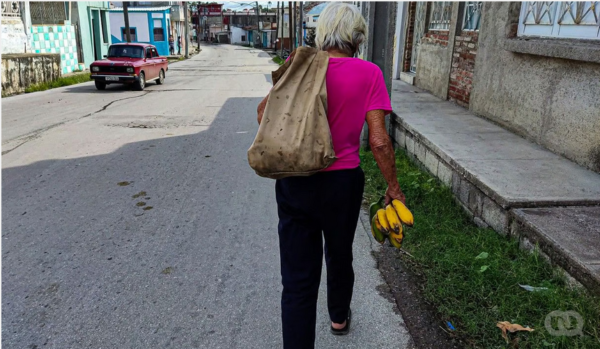Can We Believe Cuban Government Statistics on Poverty?
In stark contrast to independent study

The Cuban government routinely tries to impress with figures that the general population has no way of knowing if they represent a large or small part of the problem.
By Lorain Morales Pino (El Toque)
HAVANA TIMES – On July 15, 2024, Joaquín Alonso Vazquez, Cuba’s Minister of Economy, addressed a session of the National Assembly’s Economic Affairs Committee. He detailed several measures the Cuban Government has implemented during the last year to assist the most vulnerable population.
Among the actions, Alonso highlighted the delivery of basic necessities to 17,000 vulnerable families. He also mentioned the government’s financing of standardized family rations to 309,037 beneficiaries and 28,095 pensioners, at a cost of 477.1 million pesos (around $1.5 million USD); and the distribution of food bags to 158,396 families.
The official also stated that in the last year 18,448 persons without family support received social assistance at home through the efforts of 11,302 salaried social workers, who each attend an average of 120 households.
“We assisted 3,650 mothers of severely disabled children and subsidized the nursing homes and adult care centers of 5,382 older adults. The subsidy for family care and for the payment of electricity was maintained, and there are efforts to perfect the work of social prevention and attention, what we call social work,” stated the minister.
For his part, prime minister Manuel Marrero Cruz declared that the government budget earmarks over 5.9 billion pesos (around $19.5 million USD) to support assistance to 186,707 families, made up of 324,140 people. The programs Marrero mentioned include totally or partially paying transportation services for 50 patients who require specialized medical attention outside their local area and covering the electric bills of 214 families of patients with chronic illnesses.
Marrero also mentioned helping 1,887 people access the services of the Family Care Program, and exempting from payment 2,586 seniors who attend the old age homes and 2,796 who attend Cuba’s day program for the elderly, known as grandparents’ houses. He noted as well the temporary monetary assistance given to 45,813 people with disabilities and 114,806 older adults.
The reality for many Cubans
The latest report on Social Rights published July 16th by the Cuban Human Rights Observatory (OCDH), states that at least 89% of Cubans live in extreme poverty and face serious difficulties in acquiring essential goods. Eighty-six percent of the households surveyed have barely enough income to survive, with no possibility of purchasing additional products. In addition, 61% report problems in purchasing the bare essentials of life.
For their study, the OCDH interviewed 1,148 people, who comprised a representative sample of the country’s population. To establish the sample, they set “quotas by province and according to the age, gender and racial group balance within the population as a whole, adjusted to the demographic information from the last official census.”
The Observatory also noted that the elderly tend to perceive themselves as the most vulnerable, especially those over 70 years of age, 89% of these older Cubans admitted feeling very vulnerable.
Family remittances, which partially alleviate the situation, only reached 24% of the population surveyed. For those families, the remittances represent a considerable positive impact, although the scope of this benefit is somewhat limited by the scarcities and the rising prices of products and services. There was a very high level of disapproval for the government’s economic and social programs, with 91% of those polled classifying them as “very negative.” The number of people offering that opinion showed an increase in relation to the past two years.
The monthly income for most Cuban households is below the level that would allow them to get out of extreme poverty. This reflects a situation of economic vulnerability that affects the majority of the population.
According to the World Bank, extreme poverty is defined by the minimum amount necessary to cover basic survival needs such as food, drinking water, housing, health and education. This threshold is $1.90 dollars per day per person, at 2011 international prices. Hence, the OCDH report explains: “a household of three people will need to earn the equivalent of US $171 per month to avoid extreme poverty”.
If the exchange rate of 1 dollar for 274 Cuban pesos, assumed by the OCDH in its study, is taken as a reference, a three-person household needs a monthly income of 46,854 pesos to not be considered in the extreme poverty range. However, according to data presented by Economic Minister Alonso Vázquez, the average salary in Cuba in 2023 was a mere 5 750 pesos (less than $20 USD).
In 2021, before the recent migratory exodus, the official weekly Tribuna estimated that there were around 3.8 million households or nuclei in the country. Since then, the difficult conditions on the island have caused the departure of more than 600 thousand Cubans to the United States alone, in the period between October 2022 and June 2024.
Taking as a reference the total number of households reported in 2021, and comparing that number to the 17,000 vulnerable family nucleuses that – according to the Minister of the Economy – received aid in the form of articles of basic necessity, the Cuban government has assisted 0.45% of the country’s households.
If we take into consideration the indications of extreme poverty published by the Cuban Human Rights Observatory, we can see that the regime is incapable of alleviating the current situation of vulnerable Cuban families.
The contrast between the official version and the data from the Observatory is notable. While the government presents statistics that suggest a proactive and effective effort to mitigate poverty, the report from civil society reveals the reality of shortfalls and extensive discontent.





